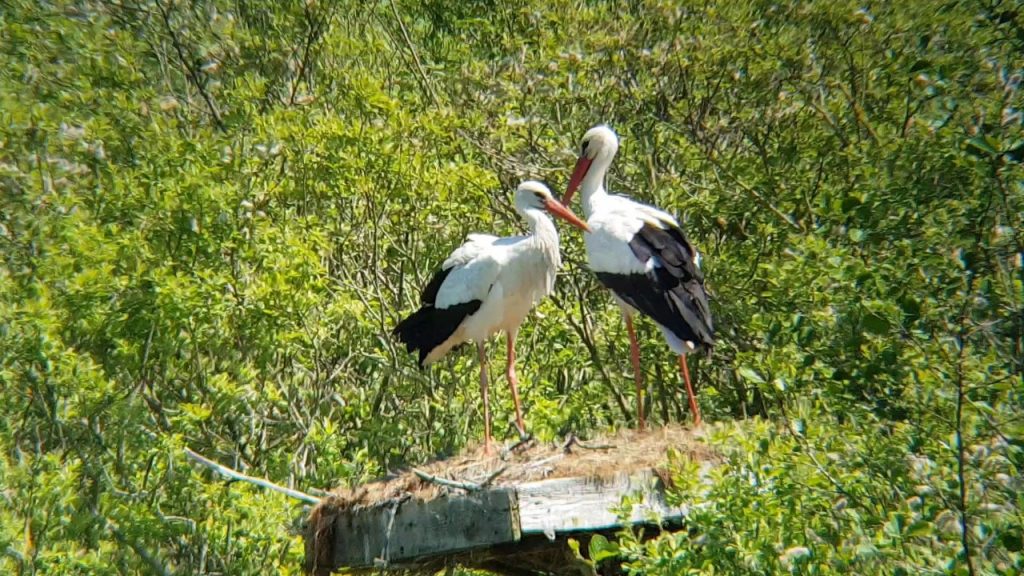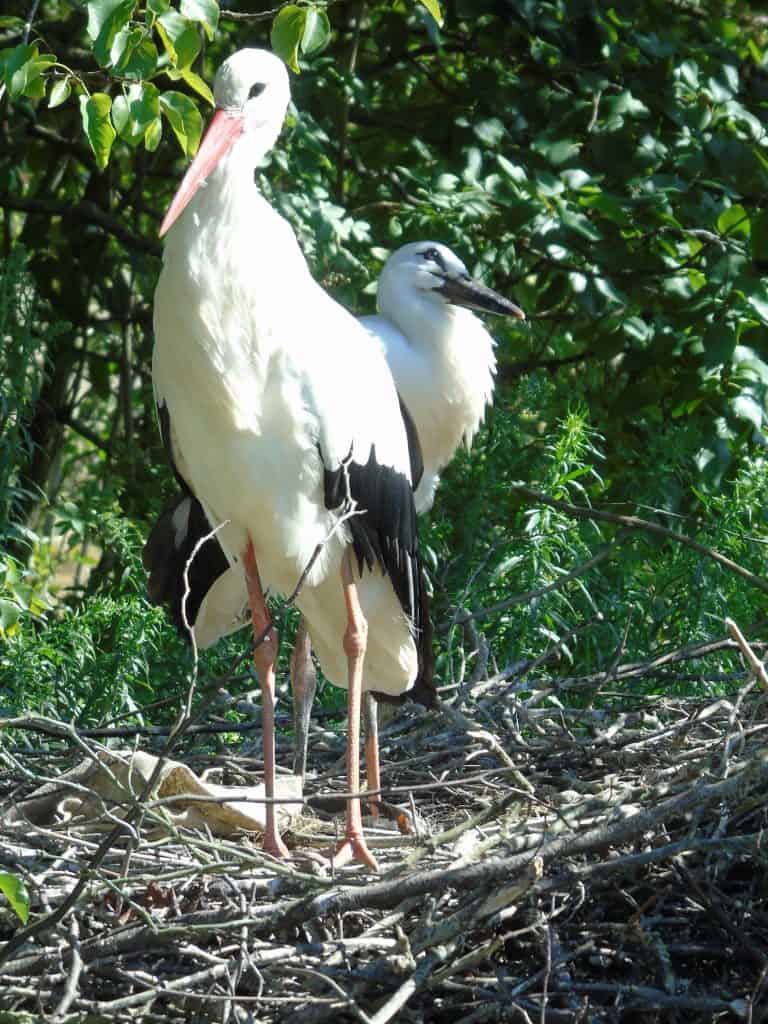If you were keeping up with our live stream videos, you may have heard that we had some exciting news whilst the park was closed during lockdown. Our White Stork pair, Rodney and Cassandra, became first time parents! In previous years, the pair had nested without success, but in my blog this week I’d love to share with you the story of this lockdown baby.
Rodney and Cassandra are both 12 years old, and their species is famous for delivering new-born babies to expecting parents. White Storks are also widely considered a symbol of good luck. Sadly, they’re not a familiar sight here in the UK anymore, being extinct as a breeding bird since medieval times. But head over to Europe and they are instantly recognisable with their white plumage, contrasting black wingtips and that huge wingspan of up to 7ft! They often nest close to people, high in trees, on poles and even rooftops.

Ciconia ciconia ciconia
There are two sub-species of White Storks and ours (Ciconia ciconia ciconia) would breed across much of Europe in the wild and migrate to Africa for the winter. White Storks migrate in flocks numbering thousands of individuals and can soar on pockets of warm air to altitudes as high as 1500m. Interestingly these “thermals” do not form over water, so they avoid the Mediterranean Sea entirely. An exhausting journey, they are particularly vulnerable to collision with powerlines and shooting along their migration routes.
White Storks live up to 30 years and form strong pair bonds, often coming back to the same nest year after year. They usually start breeding around four years old but have been known to breed as early as two years old and as late as seven years old. Around 28 are recorded in Britain each year as vagrants (scarce visitors), but the BTO also list them as being former breeders as they attempted to nest on St. Giles Cathedral in Edinburgh way back in 1416.
Stork Conservation
It’s nice to hear a positive conservation story and this is the case with these iconic birds. In 1988 they were classified as Near Threatened on the IUCN Red List. However, after various reintroductions across Europe they are now increasing in numbers and classed as Least Concern. You may have heard about a recent reintroduction project of White Storks here in the UK by the White Stork Project. Already I’m seeing birds from this project when I’m out birdwatching here in Kent, especially in the marshes surrounding my patch at Sandwich Bird Observatory. Look out for their blue leg rings!

The Storks at WWP
Here at the Park, look out for our Stork’s nest opposite the Jaguar enclosure. It is quite impressive now as the pair continue to build and add to it each year. We often see Rodney in the spring collecting little trophies for his nest. Usually he selects sticks for the nest and lines the inside with a cup of grass, but sometimes he surprises us with his choice of nesting material. The funniest addition had to be a colourful hat that we found woven into the nest.

This year the breeding season started off as usual with an interesting display. Storks are generally quite quiet with the occasional hiss here and there. But when the pair display to each other they are able to produce a mechanical sound by clapping their bills together. I love watching this behaviour with both Rodney and Cassandra throwing their heads back as they strengthen their bonds with each other.
The storks delivered a baby of their own
One morning we noticed that one of the adults was sitting down on the nest. A quick check confirmed that Cassandra had laid an egg. White Storks usually raise a single brood a year, with the female typically laying up to four eggs which are quite large, measuring about 73mm x 52mm. Both parents will need to keep the eggs warm by sitting on them. The egg should start to hatch after about 33 days… a date which we quickly make a note of on our calendars!
A quick check of the egg on the expected hatch day and we could see that at least one egg had “pipped”. In the video above you can hear a Stork chick calling inside! Our Stork chick hatched in May (2020) and just looked like a little white fluff ball at first. Both Parents were doing a fantastic job, and we just had a quick check from a distance to make sure everything was ok.
After a few days it became apparent that the remaining three eggs were infertile and were not going to hatch. But the chick seemed really strong and could often be seen asking for food. The parents regularly regurgitated food onto the nest for the youngster to eat and when the chick was old enough would start reaching into their mouths to feed. This begging call reminds me of the adult’s display to each other. Very cute at this age!
White Stork Chick
By the beginning of June, our little chick was starting to look like the adults. Interestingly the bill rapidly gets longer as the chick grows, increasing in length for about 50 days. Whilst the chick was young we were providing more insects, and we could see that mum and dad were foraging for earthworms and other insects a lot more as well. But as the chick grew, they would start to have a lot more fish and meat in their diet.

The ‘teenage’ stage
By early July the chick’s flight feathers were very apparent, but the bill and legs remained black. By mid July it was standing up a lot more on the nest and we could see that it was almost as big as Rodney! The legs and bill started to gain patches of red and it wasn’t long before it started taking a few test runs away from the nest before returning. The young usually leave the nest between 58 and 64 days after hatching. We still don’t know if we have a baby boy or girl stork. The best way to tell would be to get a feather sample DNA tested as both sexes look alike. Watch this space!

Our little teenager is now taking food from us and is fed a mixture of meat, fish and insects… as well as any invertebrates they may find around their enclosure. This is very similar to what they would be hunting in the wild with their diet consisting mainly of frogs and large insects. They also feed on young birds, fish, lizards and small mammals! The parents will usually continue feeding the juvenile for between 7 to 20 days after it has left the nest. We think our chick is now fending for itself, but doesn’t stray far from parents Rodney and Cassandra at the moment.

It’s now getting difficult to tell apart from the adults as the bill and legs are almost all red now. We hope you manage to spot our Stork family on your next visit. As always, we’d love to see any of your baby Stork photos!


